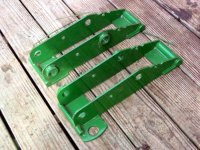Beenthere is right on time with the explanation. Notice the lynch pin at the bottom of the picture. I believe that it is retained with a cable to prevent loss. There is one on the other side of the tractor as well. If you removed these two lynch pins then you just lower the boom and back up the tractor and your unhooked. At the top of the assembly, welded to the bucket, is the hook, one on each side of the bucket. This carries most of the load and is accordingly more robust.
Look closely at the picture near the lynch pin. There is an interesting looking hole punched in the metal frame that I believe is used to store your lynch pin to keep it from dangling or getting lost if there is not a retaining cable. My dad's bucket bracket has a similiar looking cutout but it is right at the edge of the bucket and easy to flip the pin onto. A neat feature.
I really like the system and am building a shrub removal bucket that will quick attach for my father's tractor. The only thing that has me thinking is how I am going to attach those two little short pins to the new bucket or any other attachment for that matter. As described earlier, these pins have a shoulder turned on the end that gets welded. The pin is about 1" dia. and the turned part is about 5/8"dia. The turned length is about 1/4". I am going from memory but these dim's are close. Imagine drilling a 5/8" dia. hole in the bucket or attachments back plate which would be about 3/16 to 1/4" thick. When the pin is mated to the backplate, the pin could then be welded in two places. One place is on the side of the bucket where the 1" dia part of the pin is. The problem here is I am seeing no evidence that JD is applying a weld here and it is probably because this is where the tractors mating bracket seats up smartly to the bucket and a weld would be in the way.
The only other place to weld is on the inside the bucket where the 5/8" dia part of the pin is sitting flush with the surface of the steel bucket material. If I were to lay a bead following this 5/8" diameter circular path, then I would have a linear bead length of 1.96". My problem here is I can't see how JD did it on my father's bucket because the bucket has a hollow fabricated in it in this region and I can't see in there.
Continuing on, I will underestimate, or maybe not, and say I am getting 1/16" penetration on my weld and it beads up another 1/16" giving me an overall weld thickness of 1/8". This would give a total weld cross sectional area of about .25 in sqr. for this one pin. both pins would give a weld area of .50 in sqr and this is what is in shear when backblading.
Maybe there something I'm missing or I'm not doing something right or maybe I'm too cautious I don't know. Like I said before, there has never been a problem with my father's and the system works great. I'll probably weld it on just like I explained.
Greg


